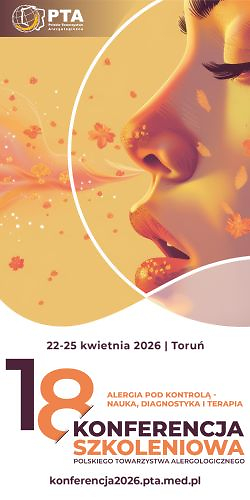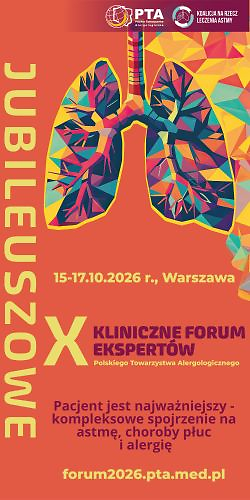|
3/2022
vol. 9
Case report
Bronchial asthma and its triggers: a case study in eastern Slovakia
- Department of Biology, Faculty of Humanities and Natural Sciences, University of Prešov, Prešov, Slovakia
- Clinic of Clinical Immunology and Allergology, Humenné, Slovakia
- Department of Physics, Mathematics and Technologies, Faculty of Humanities and Natural Sciences, University of Prešov, Prešov, Slovakia
Alergologia Polska – Polish Journal of Allergology 2022; 9, 3: 211–215
Online publish date: 2022/09/07
Get citation
PlumX metrics:
INTRODUCTION
Bronchial asthma is one of the most common chronic diseases of the respiratory system worldwide, affecting more than 300 million individuals. The more that air quality is reduced, the more the number of asthma sufferers increases. This critical condition continues to worsen not only in the child population but also in the adult population. Asthma is a chronic inflammatory disease involving cells (lymphocytes, eosinophils, neutrophils), which leads to bronchial hyperactivity. The respiratory system reacts to irritating stimuli caused by seemingly harmless substances such as pollen, animal hair, fruit, psychological stress, or air pollution. Individuals develop visible symptoms such as changes in breathing, wheezing, chest heaviness, and coughing. Asthma is a disease that also affects an individual’s overall life at rest or at work, where it results in difficulty breathing and often the inability of the individual to perform more demanding tasks. It also affects the individual’s psychological or emotional status, where it may manifest as depression, anxiety, or reduced self-control. Treatment of asthma is a long-term or lifelong process. Even though this disease is incurable, it has an excellent prognosis with proper adherence and treatment. Early diagnosis and effective treatment are the cornerstones of treatment. It is important for the patient to be familiar with the technique and correct application of medication, and to be aware of the necessity of treatment even in the asymptomatic period [1].
CASE REPORT
Bronchial asthma is a heterogeneous inflammatory disease of the tissues of the respiratory system, characterized by chronic inflammation of the airways, in which the concomitant phenomena are dyspnoea, cough, wheezing, and others. Manifestations are variable [2]. The cause of this disease is inflammation of the airways, which persists even when the patient does not experience any difficulties. Untreated allergies or non-allergic air pollutants can often contribute to the worsening of asthma. Difficulty in breathing is caused by muscle spasm in the breathing muscles. This is followed by swelling of the lining of the airways and the production of thick mucus in the lungs, which is another cause of difficult breathing. The narrowing of the airway lumen causes audible wheezing in the lungs during inspiration and expiration [2]. This disease is based on an individual’s genetic predisposition, where sensitization leads to inflammation that causes bronchial hyperactivity, resulting in airway remodelling with asthma symptoms [3]. According to the degree of severity, bronchial asthma is divided into 4 groups: intermittent, persistent mild, persistent moderate, and persistent severe asthma. The severity of bronchial asthma is assessed according to the intensity and frequency of daytime and nighttime symptoms, the intensity and frequency of disease exacerbations, the frequency of rescue medication use, the degree of lung function impairment, and the limitation of any activity [3]. In terms of phenotype, several types of asthma can be distinguished. The first type is the so-called eosinophilic allergic asthma, in which allergy is prominent and sensitisation to moulds is the most severe. The second type is non-eosinophilic non-allergic asthma, where bronchial hyperactivity and symptoms typical of asthma are present. Other types of asthma include asthma with obesity, asthma with fixed airway obstruction, late-onset asthma, and others [4, 5]. The triggers of bronchial asthma can be divided into 2 basic groups: intrinsic and extrinsic environmental factors. Allergens are the most important sensitizing and provoking factors in the context of bronchial asthma. Mites, animal hair, or food allergens are perennial allergens. Pollen and mould spores are seasonal allergens. Allergens of the genus Alternaria and Cladosporium have been implicated as risk factors for asthma in several studies [6, 7].
The main aim of our study was to investigate the association between the control of inhalation technique and the gender of the patients. The control of the correctness of inhalation technique was assessed by a nurse. Another aim was to ascertain the association between the gender of asthma sufferers and the allergens that were identified as asthma triggers. We also hypothesized a statistically significant correlation between worsening of symptoms and season. In our study, we sought to find a statistically significant correlation between early morning worsening and coughing.
Based on the data obtained from the anonymous questionnaire – Asthma bronchiale, we processed the data using mathematical and statistical methods. A total of 500 respondents completed the questionnaire, 250 were women and 250 were men. The most represented age group was in the range of 31–47 years, comprising 37.20% of the females and 32.00% of the males. The least represented group was 65–81 years, which was 16.00% of the females and 17.20% of the males. There was significant difference in the mastery of inhalation technique in the male (26.40%) and female (97.20%) populations. The most common triggers of disease in the female population were pneumonia (40.80%), while in the male population allergens were predominant (44.00%). The earliest identified first symptoms of bronchial asthma included irritant cough, the presence of which was confirmed in most of the respondents interviewed. Its presence was prevalent in both the female (40.00%) and male (31.60%) populations. Cough is a common symptom of asthma; it was present in 62.80% of the female population and very frequently in 52.00% of the male population interviewed. It occured sporadically in 28.80% of the female population and in 30.00% of the male population.
We used phenomenological analysis to determine the absolute and relative frequencies, and inductive statistics methods in which we used the chi-square test to assess the hypotheses. Using the calculated and selected significance levels, by comparing them, we refuted and confirmed the hypotheses, respectively. Thus, the aim of statistical testing was to accept or reject the stated hypotheses (H1 to H4). We processed the obtained data using Statistica v.12 statistical software. In the statistical evaluation we used Fisher’s exact test or Pearson’s c2 test.
The individual hypotheses were based on the research questions, and we investigated the association between the patient’s gender and differences in control of inhalation technique according to the gender of the respondents, and the association between asthma and allergens that were identified as asthma triggers. We also hypothesized an association between worsening of symptoms and the season, and worsening of health status early in the morning and coughing. We present the results in tables. Based on the values of the test statistics and the significance levels that resulted from the statistical processing, we can assess whether a statistically significant association was demonstrated between the variables. Based on this finding, the individual hypotheses can be refuted or confirmed. The results of the statistical tests are reported with a p-value (probability level). If this value is lower than the chosen significance level (0.05), the rejection of the hypothesis occurs at the 0.05 level. To interpret the results, we introduced a convention for denoting the level of statistical significance: p < 0.05* = low level of significance, p < 0.01** = medium level of significance, and p < 0.001*** = high level of significance.
RESULTS AND DISCUSSION
H1: We hypothesize a statistically significant association between gender and control of inhalation technique.
TESTING HYPOTHESIS 1 (TABLE 1)
In testing hypothesis 1, there was a significant association between respondents’ gender and control of inhalation technique in relaxant treatment. The calculated significance level is p < 0.001, with a relationship of p < 0.001. Predominantly males do not control the correct inhalation technique, which may lead to failures in the treatment of bronchial asthma.
H2: We hypothesize a significant association between the sex of asthma sufferers and the allergens identified as asthma triggers.
TESTING HYPOTHESIS 2 (TABLE 2)
In our research, we were interested in the possible association between patient gender and allergens that may have been identified as asthma triggers. Based on the treatment of this hypothesis and the resulting significance level (p = 0.000003), we confirmed this hypothesis according to the p < 0.05 relationship.
H3: We assume a statistically significant correlation between worsening of symptoms and season.
TESTING HYPOTHESIS 3 (TABLE 3)
In hypothesis 3, we were interested in the dependence of the occurrence of symptoms of bronchial asthma on the season. We can conclude that the most significant association emerged in spring and autumn, when there is not only an increased prevalence of pollen in the air, but also an increased prevalence of viral infections and viral illnesses. Considering the significance level (p = 0.001), we can confirm our hypothesis.
H4: We do not expect a statistically significant correlation between early morning ill health and cough.
TESTING HYPOTHESIS 4 (TABLE 4)
In determining this hypothesis, we focused on the association between ill-health and cough (specifically its frequency). The calculated significance level (p = 0.066) confirms the hypothesis. We can conclude that increased cough irritability occurs early in the morning.
CONCLUSIONS
As a result, the number of individuals suffering from bronchial asthma is increasing. Although it is a lifelong disease, the correct treatment can significantly improve a patient’s quality of life. It is therefore important that patients are made aware of the risks of not taking medication, that they are given a detailed demonstration of how to handle the relaxer, and that they are able to operate the device themselves. The results of our research highlight the fact that despite the warnings attributed to this disease the public are failing to increase their knowledge of asthma management.
ACKNOWLEDGMENTS
We would like to thank everyone who participated in our research and questionnaire survey in any way.
REFERENCES
1. Šperková Ľ. 2018. Bronchiálna astma. Available from: https://www.alphamedical.sk/casopis-invitro/bronchialna-astma 2.
Hrubiško M. Alergológia. Martin, Osveta 2003. 3.
Hrubiško M. Asthma Bronchiale. Bonus, Bratislava 2010. 4.
Meth M. What are the different types of asthma? Med News Today 2020. 5.
Reddel K, Bacharier L, Bateman E, et al. Global Initiative for Asthma Strategy 2021: executive summary and rationale for key changes. J Allergy Clin Immunol 2022; 10: S1-18. 6.
Špičák V. Alergologie. Galén, Praha 2004. 7.
Subbarao P, Mandhane PJ, Sears MR. Asthma: epidemiology, etiology and risk factors. CMAJ 2009; 181: E181-90.
Copyright: © Polish Society of Allergology This is an Open Access article distributed under the terms of the Creative Commons Attribution-Noncommercial-No Derivatives 4.0 International (CC BY-NC-SA 4.0). License (http://creativecommons.org/licenses/by-nc-sa/4.0/), allowing third parties to copy and redistribute the material in any medium or format and to remix, transform, and build upon the material, provided the original work is properly cited and states its license.
|
|












